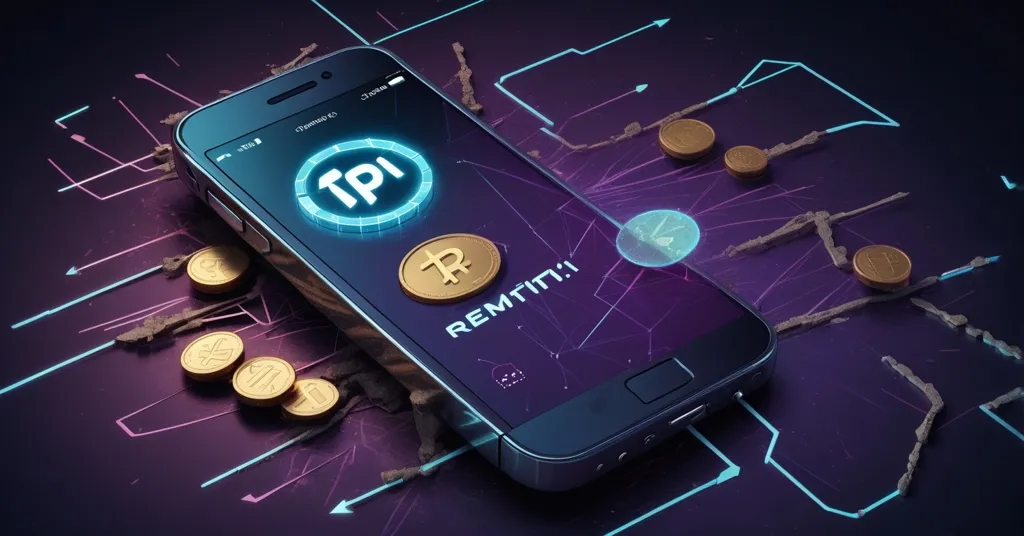Pi Coin Faces 2026 Price Crash as Remittix Shines in DeFi with $26.7M Presale

Pi Coin Price Crash Predicted for 2026 as Remittix Gains Traction in DeFi
Bitcoin remains the gold standard of crypto, but the altcoin battlefield is littered with broken promises and fleeting hype. Pi Coin, once a darling of mobile mining, now faces a grim forecast with 90% of experts predicting a price collapse by 2026 due to stagnant adoption and shaky fundamentals. Meanwhile, Remittix (RTX), a new DeFi player targeting cross-border payments, is stealing the spotlight with a $26.7 million presale and a clear focus on real-world utility.
- Pi Coin’s Decline: Trading at $0.2633, down 1.64% in a day, with experts warning of further drops over lack of utility and scalability woes.
- Remittix’s Rise: A PayFi solution raising millions, with upcoming listings on BitMart and LBANK, and top security creds from CertiK.
- Market Truths: Utility separates survivors from casualties in today’s ruthless crypto arena.
Pi Coin: Hype Without Substance
Launched around 2019, Pi Network introduced Pi Coin with a seductive pitch: mine crypto straight from your smartphone, no fancy hardware needed. It was marketed as a democratic twist on Bitcoin’s energy-hungry mining, promising accessibility to the masses. Millions downloaded the app, “mining” tokens by simply checking in daily. The hype was real—until it wasn’t. Today, Pi Coin trades at a lackluster $0.2633, down 1.64% in the last 24 hours, despite a market capitalization of $2.15 billion (that’s the total value of all tokens in circulation, calculated by price times supply). The amount of Pi bought and sold daily hit $55.67 million recently, up 16.85%, but the numbers don’t lie—most of this is speculation, not genuine demand.
So why the pessimism? A staggering 90% of crypto analysts surveyed by industry watchers flag Pi Coin as high-risk, predicting a steep decline by 2026. The core issue is a total lack of real-world adoption. What can you actually do with Pi Coin? Unlike Bitcoin, often seen as digital gold for storing value, or Ethereum, which powers a vast ecosystem of decentralized apps via smart contracts, Pi Coin offers… well, not much. It’s like selling tickets to a concert that might never happen—lots of excitement, zero delivery. Early adopters stockpiled tokens expecting a moonshot, only to find themselves holding a digital bag of hot air. That $2.15 billion market cap looks shiny, but when value is fueled by hype rather than substance, it’s a house of cards waiting to tumble. For a deeper dive into these bearish predictions for Pi Coin, the data paints a stark picture.
Then there’s the technical side. Scalability—how well a network handles growing users and transactions without crashing—remains unproven for Pi Network. Bitcoin processes about 7 transactions per second, Ethereum around 15-30; Pi’s capacity is a big fat question mark since it hasn’t faced real stress tests. Rumors persist that it uses a version of the Stellar Consensus Protocol, a less resource-heavy mechanism than Bitcoin’s proof-of-work, but without transparent data or a functioning mainnet (a fully operational blockchain), skepticism reigns. Add to that an unclear roadmap—a public plan of development milestones like partnerships or network launches—and investors are left in the dark. In crypto, uncertainty equals gambling, and the market has little patience for projects that can’t deliver. We’ve seen this before with forgotten altcoins like Electroneum, another mobile mining experiment that fizzled out. Pi Coin’s community of over 30 million users, per team claims, might be loyal, but loyalty doesn’t pay the bills—or sustain a token’s worth.
Let’s not sugarcoat it: Pi Network’s initial accessibility was a clever hook, but without purpose, it’s just noise in a crowded space. Could a drastic pivot save it? Maybe, if the team unveils a killer use case or partnerships overnight. But history suggests projects stuck in limbo rarely recover. The crypto graveyard is full of “revolutionary” ideas that couldn’t cross the utility chasm. Pi’s roadmap is murkier than a swamp—good luck navigating that without sinking.
Remittix: A DeFi Solution for Real Problems?
While Pi Coin flounders without direction, Remittix (RTX) is stepping up with a mission to tackle one of finance’s oldest headaches: cross-border payments. For the unversed, these are transactions between parties in different countries, often bogged down by high fees (think 5-7% per transfer via banks or services like Western Union), slow processing (days, not minutes), and layers of middlemen. Remittix positions itself as a PayFi solution—decentralized finance (DeFi) tailored for practical payment use cases, using blockchain to cut costs and speed things up. Their token, RTX, sits at $0.1130, and their presale has raked in over $26.7 million with 672 million tokens sold. That’s not chump change; it signals serious investor interest in a market hungry for utility.
Remittix isn’t just banking on promises. Listings on major exchanges like BitMart and LBANK are confirmed, which should boost liquidity (the ease of buying and selling tokens without wild price swings) and visibility. Security is another feather in their cap—CertiK, a top blockchain auditing firm, ranks Remittix #1 among pre-launch tokens for safety and legitimacy. In a space where scams and rug pulls—when developers vanish with investor funds, leaving worthless tokens—are rampant, that’s a big deal. It’s not a guarantee against failure, but it’s a hell of a better starting point than most.
Practically speaking, Remittix offers low gas fee transfers (the cost of processing transactions on a blockchain, often a pain point on networks like Ethereum where fees can hit $5-10 or more during peak times). Their tech likely leverages a cheaper blockchain like Binance Smart Chain or a layer-2 solution, though specifics remain under wraps. They also provide staking—locking up tokens to earn passive rewards, akin to interest in a savings account—plus a 15% USDT referral program to spur growth. A beta wallet release is slated pre-launch, and a $250,000 giveaway sweetens the deal for early adopters. Compared to Pi Coin’s stagnant ecosystem, this is a breath of fresh air. Remittix isn’t riding on memes or blind FOMO; it’s aiming for a niche that could disrupt traditional systems like SWIFT, the global banking network notorious for inefficiency.
Still, let’s pump the brakes. Presale success doesn’t equal long-term viability. Plenty of DeFi projects have soared early only to crash post-launch under technical strain or regulatory heat—look at some 2021 ICOs that promised the moon and delivered dust. Low fees sound great, but can they hold up under heavy network use? Staking rewards are enticing, but they often come with risks like impermanent loss (losing value if token prices shift while staked). And while CertiK’s nod is reassuring, no audit catches everything. Remittix has momentum, but the road to 2026 will test whether it’s a true contender or just another flash in the pan.
Bitcoin’s Shadow: Where Altcoins Fit
As Bitcoin maximalists, we always circle back to the original crypto as the ultimate benchmark. Bitcoin’s strength is its unshakable decentralization, battle-tested security, and role as digital gold—a store of value immune to inflation or government overreach. With a market dominance hovering around 50%, it dwarfs the altcoin pack. But even we acknowledge that Bitcoin isn’t built for every job. Its transaction speed (7 per second) and cost (averaging $1-2, sometimes spiking) make it clumsy for everyday payments or complex apps. That’s where altcoins and other blockchains like Ethereum, with its smart contract empire, carve out niches. The catch? They must prove complementary value, not just speculative buzz.
Remittix, if it executes, could fit this mold by streamlining cross-border transfers—a pain point Bitcoin doesn’t address well. Imagine sending money from the US to Nigeria without a bank taking a 7% cut or delaying it three days; that’s the kind of disruption crypto was born for. Pi Coin, on the other hand, sits in no-man’s-land, neither a store of value like Bitcoin nor a functional tool like, potentially, Remittix. Its mobile mining dream once echoed crypto’s ethos of accessibility, but without a working product, it betrays that promise. Bitcoin sets the bar for trust and longevity; altcoins must justify their existence by solving real problems, not riding hype waves.
Market Context: Utility Over Hype
The crypto market is a merciless filter. Hype can ignite interest, but only fundamentals sustain it. Pi Coin’s struggles mirror a pattern—projects born from viral marketing often crumble when the spotlight fades. Think Bitconnect or countless meme coins that burned investors with empty promises. Remittix, while unproven over the long haul, at least targets a tangible issue, aligning with a growing investor preference for DeFi and PayFi solutions. Cross-border payments alone represent a $150 trillion annual market, per McKinsey data, ripe for blockchain’s borderless efficiency.
Looking to 2026, broader trends add layers of uncertainty. Bitcoin’s next halving in 2024 will likely tighten supply and spike interest, potentially overshadowing altcoins without strong use cases. Central bank digital currencies (CBDCs), already in testing by over 90 countries, could either compete with or accelerate private crypto adoption, depending on how restrictive they become. Regulatory crackdowns, like the SEC’s ongoing war on unregistered tokens, loom over DeFi projects like Remittix. And let’s not forget adoption rates—crypto’s user base grew to over 400 million in 2023, but scaling to billions demands utility, not gimmicks. Pi Coin’s mobile mining pitch once seemed poised for mass appeal, but without execution, it risks irrelevance. Remittix’s payment focus might resonate more, assuming it navigates the legal and technical minefield.
We’re all about cutting through the bullshit here. Speculative shilling—those absurd “Pi to $100 by next year!” predictions—deserves nothing but scorn. Same goes for blind faith in any presale, no matter how polished. Fundamentals over FOMO, always. Investors burned by Pi’s eroding trust are right to be wary, and even Remittix backers should stay sharp. The crypto revolution thrives on disruption, not delusion.
Key Questions and Insights on Pi Coin and Remittix
- What’s driving Pi Coin’s bearish 2026 price prediction?
A lack of real-world use, unproven ability to handle mass transactions, and a vague development plan have 90% of experts forecasting a value collapse by 2026. - How does Remittix position itself in the DeFi and PayFi space?
By targeting cross-border payment inefficiencies, securing a $26.7 million presale, earning CertiK’s top security ranking, and landing BitMart and LBANK listings, it shows early potential—though delivery is key. - Can projects like Pi Coin survive without utility?
Rarely. History shows tokens without practical purpose fade in crypto’s cutthroat landscape; Pi needs a radical shift to avoid obsolescence. - Why is real-world utility becoming non-negotiable for altcoins?
As investor skepticism rises, only tokens solving concrete issues—like Remittix with payments—gain ground over speculative plays, pushing crypto’s mission to upend outdated systems. - How do altcoins support Bitcoin’s role in financial disruption?
Bitcoin excels as decentralized digital gold, while altcoins can fill gaps like fast, cheap transactions or smart contracts, expanding adoption if they prove their worth.
The crypto arena doesn’t reward dreamers—it rewards builders. Pi Coin’s trajectory looks bleak unless the team pulls off a miracle pivot. Its $2.15 billion market cap might be fool’s gold, propped up by fading enthusiasm rather than function. Remittix, meanwhile, hints at what altcoins could become—practical, secure, tied to real financial needs. But early wins don’t guarantee endurance; execution between now and 2026 will separate pretenders from pioneers. As champions of decentralization and freedom, we cheer innovation that challenges the status quo, but never at the cost of clear-eyed skepticism. Keep watching, stay critical, and remember: the revolution waits for no one.



